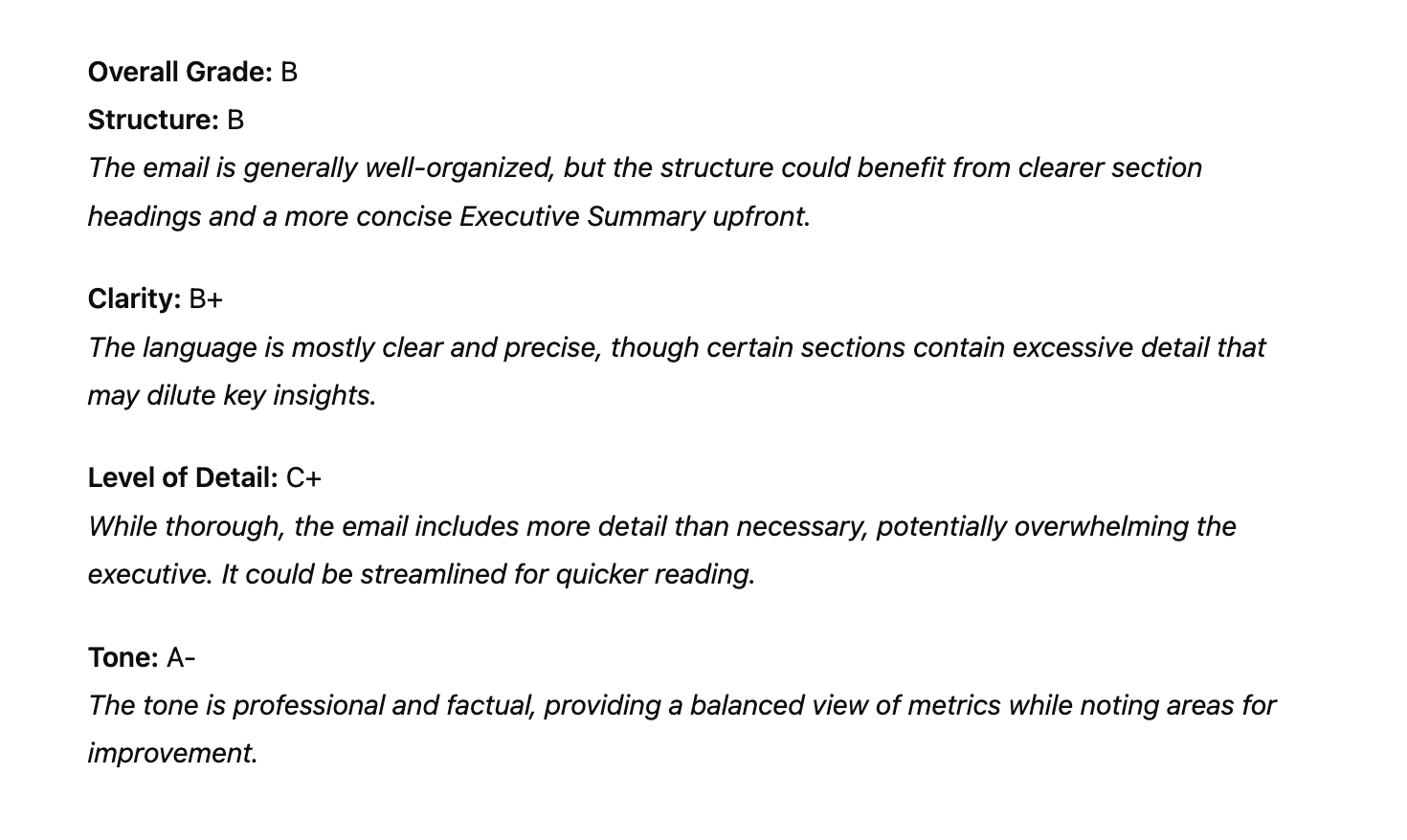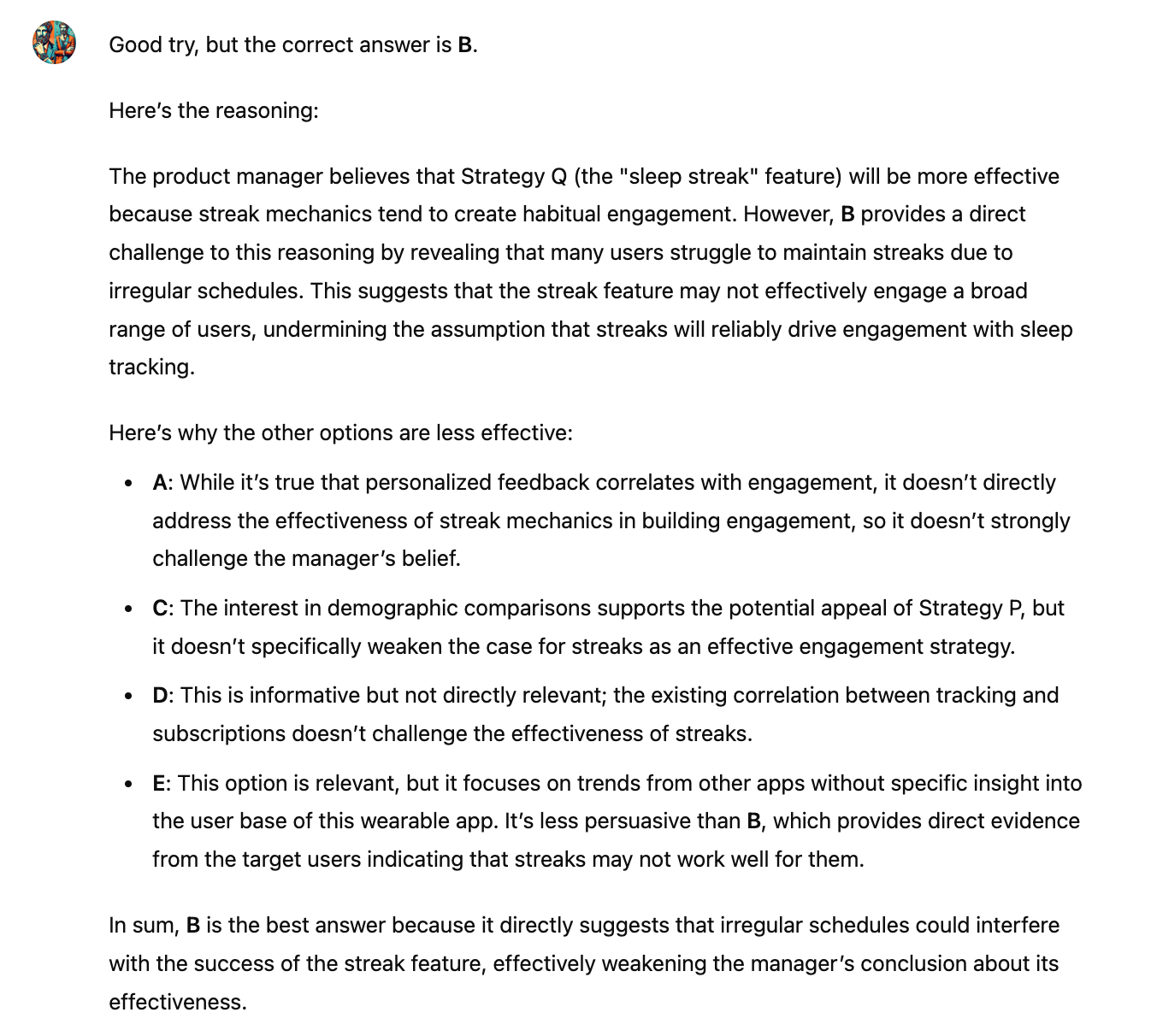👋 Welcome to a 🔒 subscriber-only edition 🔒 of my weekly newsletter. Each week I tackle reader questions about building product, driving growth, and accelerating your career. For more: Lennybot | Podcast | Hire your next product leader | My favorite Maven courses | Swag Last week’s guest post about tactics for becoming a “super IC” is on track to being my most popular post of all time, so I’m thrilled to bring you a follow-up that’s designed specifically for managers. In spite of what you may hear, we will still need (great) managers in the future—to scale (well-functioning) teams, to mentor and coach individuals, and to think beyond the day-to-day. Below, Hilary Gridley, director of product management at WHOOP, shares strategies she’s learned to leverage the latest AI tools to not just become a better manager but to level up her entire team. These tactics and tools are practical and actionable, and you can start experimenting with them today, even if you’re not managing. This post blew my mind when I first read it, and I’m very excited to share it with you. Hilary Gridley is the director of product management at WHOOP, where she oversees the core product team, including AI, Health, and Coaching initiatives, specializing in combining AI with evidence-based approaches to help millions improve their health and performance. Previously, she was a senior director of product at Big Health, a product marketer at Dropbox, and designed youth advocacy campaigns with major brands like H&M and 3M that engaged millions of young people. For more from Hilary, check out her newsletter, and follow her on X and LinkedIn. I love managing people. My team inspires me, and it’s a genuine honor to help them sharpen their skills, build resilience, exceed their own expectations, and find meaning in their work. Yet, like many managers, my calendar is packed, my unread Slack messages seem endless, and my attention is pulled in countless directions. I’ve been intrigued by the potential of AI to help managers like me spend more time coaching their teams, but most resources I’ve seen focus on productivity for individual contributors—so-called “super ICs.” This year, I fully embraced AI as a management tool, and the results have been transformative. Our team’s performance, productivity, and NPS have all reached all-time highs. One PM on the team, Alexa, says, “The team has 10x’d in efficiency and skill. Now that I have experienced AI-augmented product management and leadership, I don’t think I could work for a company where AI wasn’t allowed. It would feel equivalent to being asked to handwrite my PRDs—in cursive.” If 2024 was the year of the super IC, I predict 2025 will be the year of the supermanager. A supermanager harnesses AI to amplify their impact while fully embracing the human side of management. By scaling their efforts, supermanagers can effectively oversee larger, flatter teams and extend their coaching beyond just direct reports, fostering a culture of continuous learning throughout the organization. The skills that make for great managers—providing clear, consistent feedback and articulating the difference between good and excellent—translate remarkably well to creating GPTs that can give your team nearly unlimited access to your insights. And by helping your team develop a natural instinct for collaborating with AI, you’re not just improving their productivity; you’re building a more capable, adaptive, and high-impact product team. In this post, I’ll share the strategies that are turning this vision of the supermanager into reality for my team—and how you can do the same for yours:
Strategy 1: Level up your team’s writing skillsCommunication is a superpower in any role, but especially for product managers. A PM’s ability to drive clarity across different functions, explain decisions, and inspire their team can be the difference between high performance and burnout. To nurture my team’s writing instincts, I spend a lot of time explaining the “why” behind my edits to their documents/emails/decks/etc. While this personalized feedback is key to improving the writing and the writer, it is time-consuming, often delaying the team from getting their messages out swiftly. To scale myself, I distilled my most common writing feedback into a GPT called “The Executive Editor” (try it here). This tool allows my team to paste in their emails, decks, or Slack messages and receive a letter grade on structure, clarity, level of detail, and tone, along with actionable recommendations for improvement. Here’s an example output: Six months ago, I didn’t think this could work. But I’ve learned that LLMs are only as effective as the prompts they’re given. If you don’t know what makes writing good, it’s tough to teach a model how to evaluate or generate quality writing. However, if you’re skilled at explaining something to people—as many great managers are—you’re well equipped to teach it to an AI, allowing you to create effective GPTs that give your team unlimited opportunities to get your feedback. And while this may sound like a chore (who enjoys being graded?), my team has found it invaluable. Previously, in order to avoid becoming a bottleneck, I could review only high-stakes communications, like emails to the CEO or all-hands presentations. Now my team can receive ongoing feedback from “me” on any message they want to send at any time. One PM told me she keeps the tab open in her browser at all times. Another PM on the team, Sam, said: “I’ve been using this as my first (and second) pass on emails and decks, and it has reduced the frequency with which I run things by Hilary. It has already leveled up my game. Beyond just editing, it’s transformed my approach to executive messaging.” Creating a tool like this has a few benefits:
Of course, I’m still available to review work—and I do. But I no longer have to provide the first-round feedback I once did, since the draft has already undergone several rounds of what are essentially my suggestions before I even touch it. This allows me to dive straight into the specifics of the project, ensuring the team is getting maximum Hilary Per Minute (HPM). You can implement a similar approach in any area where you provide consistent feedback, such as PRDs, presentations, or roadmaps. The goal isn’t to remove yourself from the process; rather, it’s about ensuring that the time you do spend giving feedback is high-leverage and impactful. By empowering your team to improve their writing skills independently, you help them communicate more effectively, fostering a culture of continuous learning and growth. You can use The Executive Editor here, find the prompt I wrote for it here, and instructions for creating a custom GPT here. Strategy 2: Turn your team into debate championsMany people are drawn to product management because it’s likened to being the CEO of a product. However, the reality sets in when they find themselves in meetings with actual CEOs, who have strong opinions and an intimate knowledge of the business. It becomes clear that your power lies in your ability to influence—advocating effectively for your perspective, both on paper and in real-time discussions. The good news is that anyone can learn the logical reasoning skills needed to build a solid argument. I created a GPT specifically designed to help product managers strengthen these skills through scenario-based simulations that mirror real-world situations, such as feature prioritization or balancing competing metrics. You can try it out here. I love scenario-based learning because it helps people apply theoretical concepts to real life, with immediate feedback that creates a fast, repeatable learning loop. Here’s an example output from the GPT: While we wait for everyone to join our weekly team meeting, I’ll pull up this GPT to generate a discussion question for the team. It’s a fun, low-pressure way to sharpen our live debate skills while fostering team camaraderie (and requires no preparation from me). We decide on an answer, enter it, and the GPT provides a breakdown of the reasoning behind why each option is correct or incorrect. This allows us to learn from both the answer and one another’s thought processes. After I began integrating this GPT into our regular meetings, team members reported feeling more confident when presenting their ideas and have been more successful in influencing executives. And they can continue enhancing their skills together without time-consuming training sessions. You can implement similar AI-driven coaching tools to help your team build confidence in areas like strategic thinking or decision-making. By providing consistent, targeted practice, you empower your team to grow while you focus on the high-impact coaching moments. This approach not only elevates individual skills but also fosters a culture of learning and support within your team. You can use the logic coach here and find the prompt I wrote for this GPT here. Strategy 3: Help your team master synthesis skillsAI-generated meeting notes are a popular tool, but in my experience, they often miss the mark. They tend to drift toward broad abstractions rather than providing clarity and nuance. Good meeting notes confirm whether everyone in the room arrived at the same conclusions, which is not always obvious from transcripts, and they allow people who were not in the room to quickly understand the points of view expressed and why the room gravitated in certain directions. For PMs, synthesizing meeting notes isn’t “just admin work.” It’s a critical skill. PMs attend meetings that others don’t—like customer calls, executive strategy reviews, and technical discussions. Their synthesis of these meetings allows them to update their own perspectives and share key insights with others, so that thoughtful decisions aren’t reduced to “We’re doing this because the CEO says so.” Effective synthesis prevents miscommunication, aligns teams, and sharpens strategic thinking. However, teaching synthesis is challenging. The process of how I arrive at my own notes isn’t always clear for people who weren’t in the room. And when PMs lead meetings, they’re usually focused on immediate follow-ups, which leaves little time for practicing this skill. That’s where AI can help, but only with a balanced approach that ensures the team stays actively engaged in the synthesis process. Here’s how I encourage my team to use AI as a tool, not a crutch:... Subscribe to Lenny's Newsletter to unlock the rest.Become a paying subscriber of Lenny's Newsletter to get access to this post and other subscriber-only content. A subscription gets you:
|
Search thousands of free JavaScript snippets that you can quickly copy and paste into your web pages. Get free JavaScript tutorials, references, code, menus, calendars, popup windows, games, and much more.
How to become a supermanager with AI
Subscribe to:
Post Comments (Atom)
Top 3 UX Design Articles of 2024 to Remember
Based on most subscriptions ͏ ͏ ͏ ͏ ͏ ͏ ͏ ͏ ͏ ͏ ͏ ͏ ͏ ͏ ͏ ͏ ...
-
code.gs // 1. Enter sheet name where data is to be written below var SHEET_NAME = "Sheet1" ; // 2. Run > setup // // 3....






No comments:
Post a Comment